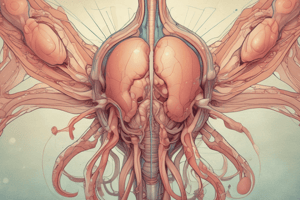Podcast
Questions and Answers
What is the result of sexual reproduction in animals?
What is the result of sexual reproduction in animals?
- Production of identical offspring
- Creation of only male offspring
- Decrease in genetic diversity
- Formation of a zygote (correct)
Which type of sex cells unite to form a zygote in animals?
Which type of sex cells unite to form a zygote in animals?
- Muscle cells
- Nerve cells
- Sperm and egg cells (correct)
- Red blood cells
What is a common mating strategy where one male mates with multiple females?
What is a common mating strategy where one male mates with multiple females?
- Monogamy
- Polyandry
- Polygamy
- Polygyny (correct)
How do animals enhance genetic diversity through sexual reproduction?
How do animals enhance genetic diversity through sexual reproduction?
What is promiscuity in the context of animal behavior?
What is promiscuity in the context of animal behavior?
Which of the following is a key component of the male reproductive system?
Which of the following is a key component of the male reproductive system?
How does fertilization typically occur in most animals?
How does fertilization typically occur in most animals?
What is a blastula in the context of embryonic development?
What is a blastula in the context of embryonic development?
Which organ produces eggs in the female reproductive system?
Which organ produces eggs in the female reproductive system?
What role does the fallopian tube play in the female reproductive system?
What role does the fallopian tube play in the female reproductive system?
Flashcards are hidden until you start studying
Study Notes
Exploring Sexual Reproduction in Animals
As we delve into the fascinating world of animal reproduction, we'll focus on sexual reproduction, a biological process that involves the interaction between male and female organisms to create offspring. This article will explore the fundamental concepts, mechanisms, and strategies that various animals employ to reproduce sexually.
Sexual Reproduction in Animals: The Basics
Sexual reproduction occurs when two sexually mature individuals come together to form a single organism, known as a zygote, by combining their genetic material. This results in a more diverse and dynamic population that can adapt to changing environments.
There are two main types of sex cells in animals: sperm (male) and egg (female) cells. When these cells unite, they form a zygote containing a combination of genetic information from both parents.
Mating Strategies in Animals
Animals employ a variety of mating strategies to secure a mate, reproduce, and protect their offspring. Some common strategies include:
- Monogamy: Some animals form long-term pair bonds for the sake of rearing their offspring. Examples include most species of birds and some primates, like gibbons and orangutans.
- Polygyny: In polygynous species, one male mates with multiple females. Examples include lions, elephants, and some species of deer.
- Polyandry: In polyandrous species, one female mates with multiple males. Examples include some species of birds, like the black-checked grosbeak and the black swan.
- Promiscuity: Many animals engage in behavior known as promiscuity, in which both males and females mate with multiple partners. Examples include many species of fish and insects.
Reproductive Organs and Reproductive Systems
Animals possess specialized organs and systems that facilitate the processes of sexual reproduction. Some notable examples include:
- Male Reproductive System: The male reproductive system enables the production and transport of sperm cells. Key components include the testes, which produce sperm, and the vas deferens, which transports sperm to the ejaculatory duct during copulation.
- Female Reproductive System: The female reproductive system enables the production and protection of egg cells. Key components include the ovaries, which produce eggs, the fallopian tubes, which transport eggs to the uterus, and the uterus, where the fertilized egg develops into an embryo.
Fertilization and Development
Fertilization occurs when sperm cells and egg cells unite to form a zygote. This union triggers a series of events that lead to the development of a new organism.
- Fertilization: In most animals, fertilization occurs when sperm cells enter the female reproductive tract and unite with the egg cell. In some species, however, external fertilization occurs when sperm and egg cells combine in a fluid medium outside the female body.
- Fertilization Success: Fertilization success depends on several factors, including the compatibility of the sperm and egg cells, the timing of their release, and the presence of sperm-blocking mechanisms in some species.
- Embryonic Development: Once fertilization occurs, the zygote undergoes a series of cell divisions and differentiations to form a multicellular organism. Examples include the development of a blastula (a hollow ball of cells) in animals like sea urchins and the development of a blastocyst (a fluid-filled sac) in mammals like humans.
In conclusion, sexual reproduction in animals is an intricate process that involves a complex interplay between genetic, physiological, and environmental factors. Through the study of sexual reproduction, biologists can better understand the underlying principles that govern the life cycles and ecological interactions of animals. This knowledge can be leveraged to develop strategies to protect and conserve endangered species and maintain diverse, healthy ecosystems.
Studying That Suits You
Use AI to generate personalized quizzes and flashcards to suit your learning preferences.




